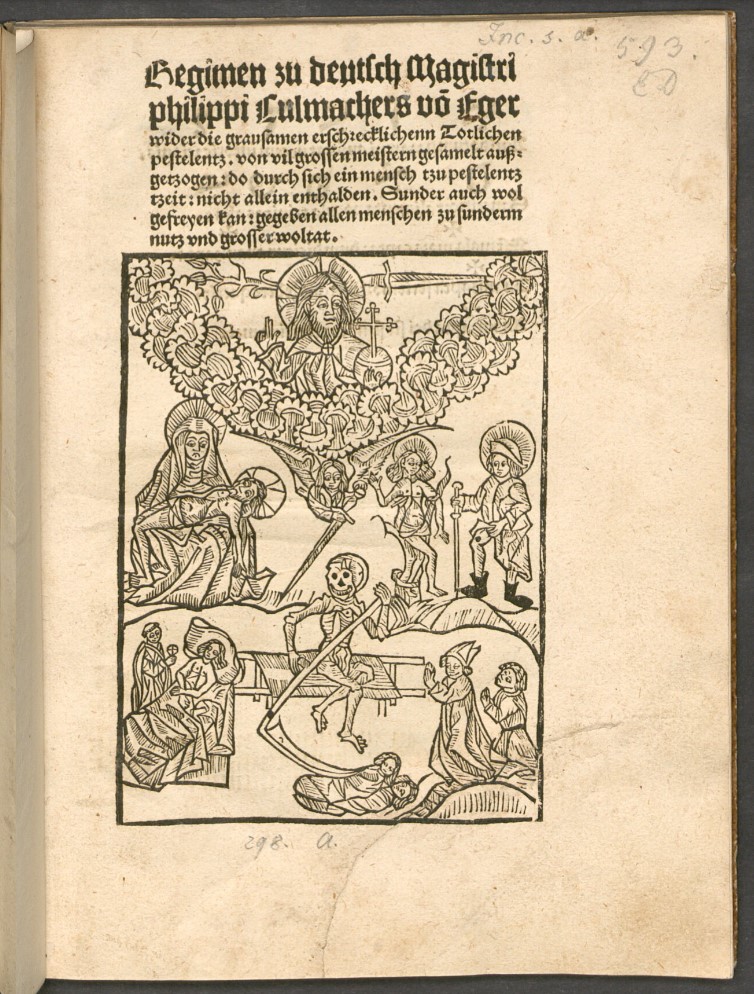Glossary
Plague sheet/book

Other languages
- Dutch: pestboekje, pesttraktaat, pestordonnantie, pestspiegel
- French: traité de la peste
- German: Pestblatt, pestschrift
- Italian: regimen de peste, trattato de peste, successo della peste
Material form
Printed book, Single-sheet printSubject
News and current affairs, Religion and moralityDescription
The plague, probably the most-feared disease in early modern Europe, generated an ongoing stream of printed materials, booklets as well as printed images, especially at times of outbreaks. Many plague tracts were small booklets (e.g. octavo) or pamphlets, discussing the causes of the disease, symptoms, and/or practical advice to avoid contagion or treat patients. Prayers could also be part of the treatment.
Particularly popular in the German regions in the 15th-17th century were the so-called Pestblätter that were ascribed protective powers against the disease. Printed as broadsheets, these Pestblätter contained a text or image (and sometimes both) invoking a saint, Christ or God in a request to protect oneself against the plague or to prevent death in cases when the plague had already manifested itself. ‘Plague’ did not necessecarily refer to the black death, but could in principle be applied to any relevant spreading pestilence (i.e. epidemic disease). The Pestblätter were usually carried around as a sort of protective amulet.
Spanish nóminas had a similar amulet function, considered to protect against diseases but also other evils. These cheap single-sheet prints contained holy names and prayers that had to be recited repeatedly for protection. They were in essence a kind of form, as the name or description of what had to be protected was to be inscribed by hand.
In Italy, too, since the Middle Ages, printed orations and images circulated that were to be worn as amulets. These types of print, as well as printed verses and songs, were popular during outbreaks of the plague.
In the Dutch Republic and Italy we encounter plague booklets and plague treatises, aimed at understanding and prevention. Italian successi della peste described recent outbreaks.
Early modern England experienced a similar production of plague genres, ranging from plague orders, plague treatises, pamphlets, sermons, bills of mortality and (single-sheet) advertisments/handbills.
In France throughout the early modern period many plague tracts were published, of which a large share were named Traité de la peste. Usually they comprised a dedication and/or preface, a description of the causes of the disease, a list of signs/symptoms, the course of the disease and its treatment and finally a way how to avoid further contamination. There was a large diversity of plague texts however, varying in length between four and four hundred pages.
Related terms
medical literature, broadsheet, devotional literature, plague tract, plague treatise, plague pamphlet
Sources
J.-N. Biraben, Les hommes et la peste en France et dans les Pays européens et méditerranéens (Paris: Mouton, 1975).
E. Brenner, ‘Spotlight: A Solitary Survivor of the Great Plague’, blog Wellcome Library, 1 October 2015, http://blog.wellcomelibrary.org/2015/10/spotlight-a-solitary-survivor-of-the-great-plague/
S.K. Cohn, Cultures of Plague: Medical Thinking at the End of the Renaissance (Oxford: Oxford University Press, 2010).
J. Coste, Représentations et comportements en temps d’épidémie dans la littérature imprimée de peste (1490-1725). Contribution à l’histoire culturelle de la peste en France à l’époque moderne (Paris: Honoré Champion Éditeur, 2007).
M. Fissell, ‘Popular Medical Writing’, in: J. Raymond (ed.), The Oxford History of Popular Print Culture, Vol. 1 (Oxford: Oxford University Press, 2011), 417-430.
S. González-Sarasa Hernáez, Tipología editorial del impreso antiguo español, thesis Universidad Complutense de Madrid (2013), 343-344 (‘Nómina’). https://eprints.ucm.es/id/eprint/24020/
E.A. Heinrichs, Plague, Print, and the Reformation: The German Reform of Healing, 1473-1573 (New York & London: Routledge, 2017).
P. Heitz, W.L. Schreiber (eds.), Pestblätter des XV. Jahrhunderts, Einblattdrucke des fünfzehnten Jahrhunderts vol. 2 (Strasbourg: Heitz und Mündel, 1918), 2nd ed. (first published 1901), .
C. Jones, ‘Plague and Its Metaphors in Early Modern France’, Representations 53 (1996), 97-127.
L. Jones, Patterns of Plague: Changing Ideas about Plague in England and France, 1348–1750 (Montreal: McGill-Queen’s University Press, 2022). https://doi.org/10.1515/9780228012986.
J. Marr, Kriege und Seuchen. Spätmittelalterliche Katastrophen und ihre Reflexion in den deutschen Einblattdrucken von 1460 bis 1520, Inaugural-Dissertation zur Erlangung des Grades eines Doktors der Philosophie am Fachbereich III der Universität Trier im Fach Mittelalterliche Geschichte (Trier: 2010).
S. Minuzzi (ed.), La peste e la stampa. Venezia nel XVI e XVII secolo (Venice: Marsilio, 2020).
L. Noordegraaf and G. Valk, De gave Gods. De pest in Holland vanaf de late Middeleeuwen, 2nd ed. (Amsterdam: Bakker, 1996).
A. Pettegree, ‘Broadsheets: Single-Sheet Publishing in the First Age of Print. Typology and Typography’, in: A. Pettegree (ed.), Broadsheets: Single-Sheet Publishing in the First Age of Print (Leiden/Boston: Brill, 2017), 1-32.
R. Salzberg, Ephemeral City: Cheap Print and Urban Culture in Renaissance Venice (Manchester: Manchester University Press, 2014).
D. Steel, ‘Plague Writing: From Boccaccio to Camus’, Journal of European Studies 11 (1981), 88-110.
A. Wear, Knowledge and Practice in English Medicine 1550–1680 (Cambridge: Cambridge University Press, 2000), Chapter. 6: Plague and medical knowledge, 275-313.
F.P. Wilson (ed.), The Plague Pamphlets of Thomas Dekker (Oxford: Clarendon Press, 1925).

